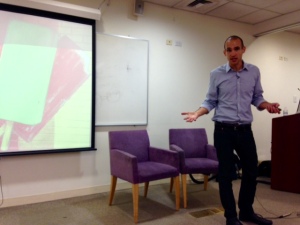Nir Eyal, an entrepreneur, designer and author, has been on the event circuit since the release of his new book Hooked: How To Build Habit-Forming Products. I recently heard him speak two days in a row at Alley Boost and StartupGrind events. Below is a post that combining what he said at both events. I guess the next step should be reading his book…it’s on my list!
Did you know that 1 out of 3 Americans would rather give up sex than their smart phone? Technology has quickly become a pervasive – and intimate – part of our lives. If you’re a designer or an entrepreneur, then you probably are dying to know how technology becomes habit-forming. And if you’re just a consumer, knowing why we get hooked is the first step in breaking unhealthy attachments to tech.
Cue Nir Eyal, entrepreneur, designer and author of Hooked, which was recently released as a physical book that explores what entrepreneurs should build and why. Eyal has a background in gaming and advertising, which both involve some form of mind control. He had his own startup and he has consulted plenty of others.
“A lot of companies were using these [habit-forming] tactics and yet they didn’t really understand why these tactics work,” said Eyal. “They do it without understanding the deeper psychology on how and why these things change users’ behavior.”
Companies want to create products that customers won’t just love, but won’t be able to put down. These types of addictive technologies like our phones, email and apps have a hook so compelling, that we keep using them without anyone prompting us to come back. They become habit, which is a behavior done with little or no conscious thought. This accounts for what we do for about half our day.
There are four parts to the hook, Eyal said.
1. The trigger is something that tells the user what to do and cues the next action. It can be external or internal. Most of these internal triggers are negative – our pain points that we look to solve. We form habits with technologies that lift us out of these negative states, like loneliness or boredom.
When we are lonely we use Facebook. When we’re unsure we go to Google. When we’re bored there’s YouTube, Pinterest, ESPN, etc. Studies show that people suffering from depression check email more often.
2. The action is the simple behavior done in anticipation of a reward. Examples are scrolling, searching or hitting the play button. The formula, created by B.J. Fogg, for predicting the likelihood of these singular actions is behavior = motivation + ability + trigger.
6 factors that can increase motivation are seeking pleasure, avoiding pain, seeking hope, avoiding fear, seeking acceptance and avoiding rejection. Every ad uses one or more of those levels of motivation.
6 factors that affect ability are time, money, physical effort, brain cycles (how hard it is to understand correlates with likeliness of doing it), social deviance (see other people doing it), non-routine (you’re more likely to do it if you’ve done it before).
3. The reward: We like variability; the uncertainty makes returning to the technology exciting. An example is the newsfeed, it’s always different.
4. The investment: The product should have a return on the investment because users put something into it in anticipation of a future benefit. Investments increase the likelihood of passing through the hook. Example – if you send a message on WhatsApp, you’ll get one back. Habit-forming technology should improve or appreciate rather than depreciate over time. Another type of investment is building a reputation or a following, like on Task Rabbit, Ebay or AirBnB. It’s hard to leave that platform once you have value on it.
While all this information has value for designers, changing someone’s behavior to meet our own ends, is a form of manipulation, said Eyal. He believes companies should practice social responsibility and use the psychology of the hook to make products that are good for us.
At Startupgrind, Eyal answered my Twitter question and I had 5 seconds of fame…within the event:
question for @nireyal: what do you think could be our next addiction/which of our emotions isn’t being exploited…yet? @StartupGrindNYC
— Danielle Brody (@dbny23) November 6, 2014
He handled the cynicism well, and said the emotions we want to manage don’t change, the technology and interface do. He predicts n a few years wearable technology, like Google Glass and smart watches will be the next big thing.
At the same time he’s teaching the hook, Eyal calls himself an advocate for breaking hooks. You can use the information to break habits and build good ones, he said. In the future, being able to control our habits will be a competitive advantage, said Eyal.
Maybe he’s saying we swap the juice cleanses and do the digital detox to prep for 2015? Maybe I’ll wait til 2016…Eyal’s “future” has no deadline. 🙂






